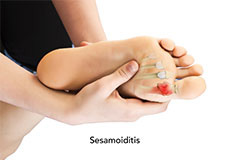
What is Sesamoiditis?
Sesamoids are two small, pea-shaped bones located in the ball beneath the big toe joint at the bottom of the foot. Sesamoid bones are connected to muscles and other bones by tendons that envelop these bones. Sesamoids help the big toe move normally and absorb the weight placed on the ball.
Sesamoiditis is inflammation of the sesamoid bones and the tendons in the foot. The condition occurs when the tendons attached to and surrounding the sesamoid bones become injured, irritated and inflamed. It is a form of tendinitis (inflammation of the tendon).
Sesamoiditis is caused by:
- Overuse and straining of the tendons.
- Increased pressure on the sesamoids.
Sesamoiditis is common among runners, basketball, baseball or football players, and ballet dancers. People with high foot arches and older adults with osteoarthritis may also experience sesamoiditis. The condition can also be caused by sesamoid bone fractures or by another condition called osteonecrosis (death of bone tissue).
What are the Signs and Symptoms of Sesamoiditis?
The main symptom of the condition is a gradual onset and build-up of pain in the forefoot at the bottom. The pain develops under the big toe and on the ball of the foot. Other signs include:
- Difficulty in straightening or bending the big toe.
- Pain when the big toe is moved, resulting in limping.
- Pain in the foot when pressure is applied or with weight-bearing.
- “Pop” sensation in the big toe during walking.
What if Sesamoiditis is Left Untreated?
If sesamoiditis is not treated, it may lead to serious complications such as:
- Prolonged and chronic pain in the forefoot.
- Weakness and deformity of the big toe.
- Fracture of the sesamoid bones in the foot.
How is the Condition Diagnosed?
Diagnosis of sesamoiditis begins with a physical examination of the foot. The doctor is likely to check for tenderness and pain around the sesamoid bones and the ball of the foot. The doctor may try to bend and move the big toe in different directions to assess flexibility. An X-ray of the forefoot may be ordered to confirm the condition. The doctor may also recommend other tests such as an ultrasound or an MRI or even a bone scan to check for tendon injuries or a sesamoid bone fracture.
How is Sesamoiditis Treated?
Typically, sesamoiditis does not require surgery and is generally treated conservatively. Your doctor decides on the precise treatment depending on the degree of severity and may include one or more of the following.
- Rest: Mild cases of sesamoiditis can resolve with adequate rest coupled with icing and elevation of the foot. Activities worsening the pain need to be avoided.
- Immobilization: The foot may be placed in a removable cast. Crutches may also be used to prevent placing weight on the foot.
- Physical therapy: This treatment involving certain exercises along with ultrasound therapy after the immobilization, helps to reduce inflammation.
- Anti-inflammatory medications: A cortisone or steroid injection, oral medications and nonsteroidal anti-inflammatory drugs (NSAIDs) can help reduce swelling and pain.
- Lifestyle changes: - High heels need to be avoided and be replaced with soft-soled and low-heeled shoes. Orthotics like padded insoles or cushioning pads may be beneficial.
- Padding, strapping or taping: The big toe may be taped or strapped to stretch and relieve pressure on the toes. This is known as plantar flexion.
If symptoms persist, the doctor may recommend wearing a removable, short leg brace for 4 to 6 weeks. This can reduce pain and pressure. It may take up to 6 weeks for at-home treatments to relieve the pain associated with sesamoiditis.
Surgery
If conservative measures fail, surgical removal of one sesamoid bone may be necessary.
It is good to only remove one of the two sesamoids. If both are taken out, it can lead to big toe deformity.
During surgery, the surgeon makes an incision on the bottom of your foot and then separates the soft tissue around the sesamoid bone. Once the bone is removed, the soft tissue is put back in place, and the incision is closed.
Recovery from a sesamoid injury may take 3 to 6 months.






